(完整word版)初中英语时间方位介词.pdf
- 格式:pdf
- 大小:147.95 KB
- 文档页数:18
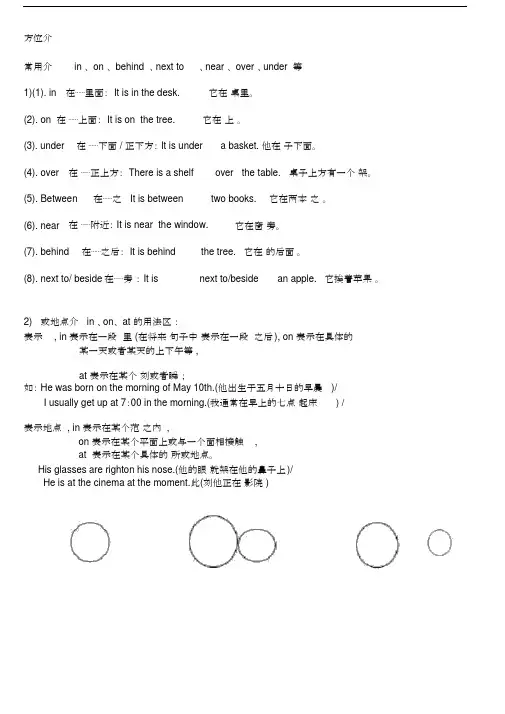
方位介常用介in 、 on 、 behind 、next to 、near 、 over 、under 等1)(1). in 在⋯⋯里面: It is in the desk. 它在桌里。
(2). on 在⋯⋯上面: It is on the tree. 它在上。
(3). under 在⋯⋯下面 / 正下方: It is under a basket. 他在子下面。
(4). over 在⋯⋯正上方: There is a shelf over the table. 桌子上方有一个架。
(5). Between 在⋯⋯之 It is between two books. 它在两本之。
(6). near 在⋯⋯附近: It is near the window. 它在窗旁。
(7). behind 在⋯⋯之后: It is behind the tree. 它在的后面。
(8). next to/ beside在⋯⋯旁:It is next to/beside an apple. 它挨着苹果。
2)或地点介 in 、on、 at 的用法区:表示 , in 表示在一段里 (在将来句子中表示在一段之后), on 表示在具体的某一天或者某天的上下午等 ,at 表示在某个刻或者瞬;如: He was born on the morning of May 10th.(他出生于五月十日的早晨)/I usually get up at 7:00 in the morning.(我通常在早上的七点起床) /表示地点 , in 表示在某个范之内 ,on 表示在某个平面上或与一个面相接触,at 表示在某个具体的所或地点。
His glasses are righton his nose.(他的眼就架在他的鼻子上)/He is at the cinema at the moment.此(刻他正在影院 )B A B A B AB 在 A 里——用in A 和B 相(接壤)——用on A 和B 不相(不接壤)——用to3) in front of “在⋯之前”(范外)in the front of 表示“在⋯的前部”(范内)演1. The United States is ____ the south of Canada and ___ the east of Japan.A. to; inB. on; toC. in; besideD. at; on2 . Japan lies____ the east of China.A. on B/ to C. in D. with3. Jiangsu is___ the east of China, but Japan is ___ the east of China.A. to; inB. in; to .C. on; toD. to; on4.There are some trees_________ the classroomThere is a blackboard ____________ the classroom.5.—Look, there are many apples ______ the tree.—Yes. And a boy is picking apples ______ the tree now.A. in; onB. on; inC. in; inD. on; on6.When did you arrive ______school this morning?A. inB. atC. toD. with。
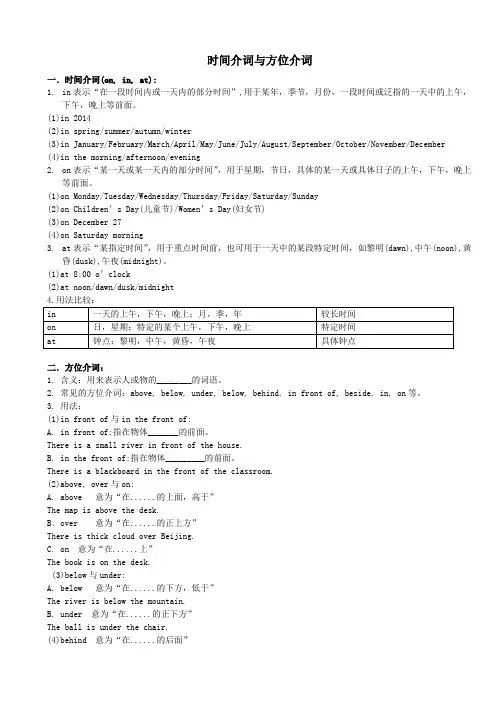
时间介词与方位介词一.时间介词(on, in, at):1.in表示“在一段时间内或一天内的部分时间”,用于某年,季节,月份,一段时间或泛指的一天中的上午,下午,晚上等前面。
(1)in 2014(2)in spring/summer/autumn/winter(3)in January/February/March/April/May/June/July/August/September/October/November/December(4)in the morning/afternoon/evening2.on表示“某一天或某一天内的部分时间”,用于星期,节日,具体的某一天或具体日子的上午,下午,晚上等前面。
(1)on Monday/Tuesday/Wednesday/Thursday/Friday/Saturday/Sunday(2)on Children’s Day(儿童节)/Women’s Day(妇女节)(3)on December 27(4)on Saturday morning3.at表示“某指定时间”,用于重点时间前,也可用于一天中的某段特定时间,如黎明(dawn),中午(noon),黄昏(dusk),午夜(midnight)。
(1)at 8:00 o’clock(2)at noon/dawn/dusk/midnight二.方位介词:1. 含义:用来表示人或物的________的词语。
2. 常见的方位介词:above, below, under, below, behind, in front of, beside, in, on等。
3. 用法:(1)in front of与in the front of:A. in front of:指在物体_______的前面。
There is a small river in front of the house.B. in the front of:指在物体_________的前面。
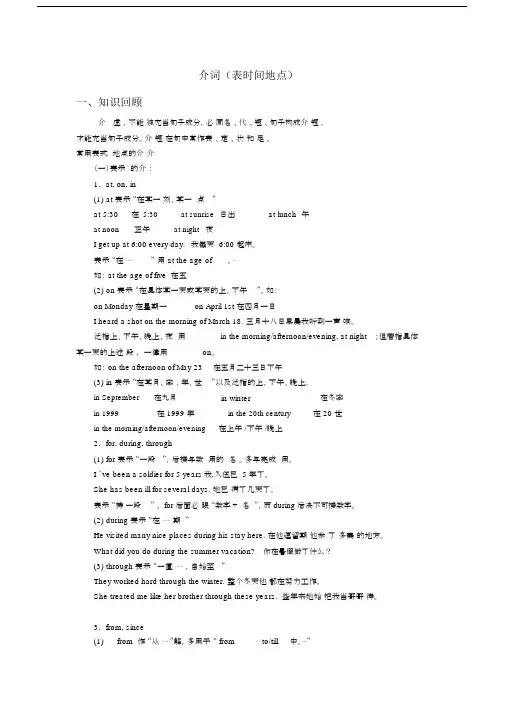
介词(表时间地点)一、知识回顾介虚,不能独充当句子成分,必同名、代、短、句子构成介短,才能充当句子成分。
介短在句中常作表、定、状和足。
常用表式地点的介介(一)表示的介:1. at, on, in(1)at 表示“在某一刻、某一点”at 5:30 在5:30 at sunrise 日出at lunch 午at noon 正午at night 夜I get up at 6:00 every day.我每天6:00起床。
表示“在⋯⋯” 用at the age of。
⋯如: at the age of five 在五(2)on 表示“在具体某一天或某天的上、下午”。
如:on Monday 在星期一on April 1st 在四月一日I heard a shot on the morning of March 18. 三月十八日早晨我听到一声响。
泛指上、下午、晚上、夜用in the morning/afternoon/evening, at night;但若指具体某一天的上述段,一律用on。
如: on the afternoon of May 23在五月二十三日下午(3)in 表示“在某月、季、年、世”以及泛指的上、下午、晚上。
in September 在九月in winter 在冬季in 1999 在 1999 年in the 20th century 在 20 世in the morning/afternoon/evening 在上午 /下午 /晚上2. for, during, through(1)for 表示“一段”,后接与数用的名。
多与完成用。
I ’ve been a soldier for 5 years我.入伍已 5 年了。
She has been ill for several days. 她已病了几天了。
表示“持一段” , for 后面必跟“数字 +名”,而 during 后决不可接数字。
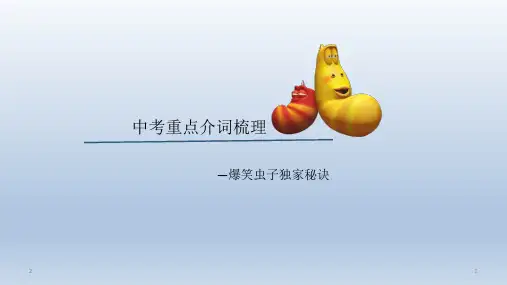
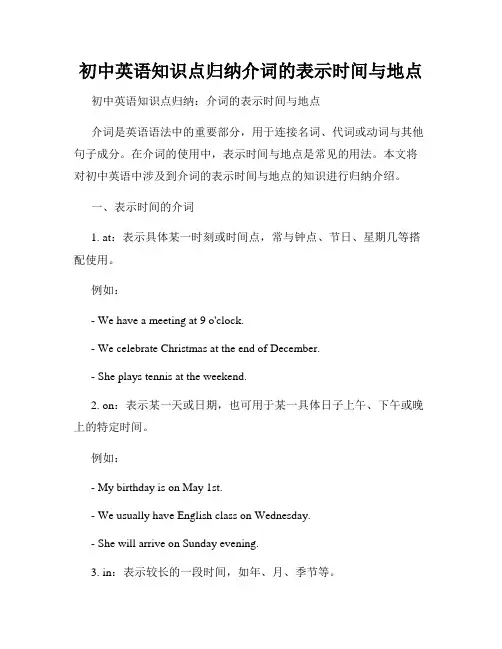
初中英语知识点归纳介词的表示时间与地点初中英语知识点归纳:介词的表示时间与地点介词是英语语法中的重要部分,用于连接名词、代词或动词与其他句子成分。
在介词的使用中,表示时间与地点是常见的用法。
本文将对初中英语中涉及到介词的表示时间与地点的知识进行归纳介绍。
一、表示时间的介词1. at:表示具体某一时刻或时间点,常与钟点、节日、星期几等搭配使用。
例如:- We have a meeting at 9 o'clock.- We celebrate Christmas at the end of December.- She plays tennis at the weekend.2. on:表示某一天或日期,也可用于某一具体日子上午、下午或晚上的特定时间。
例如:- My birthday is on May 1st.- We usually have English class on Wednesday.- She will arrive on Sunday evening.3. in:表示较长的一段时间,如年、月、季节等。
例如:- I was born in 2005.- He will go to Canada in the summer.- They always go skiing in January.4. during:表示在某一段时间内。
例如:- I read a book during the summer vacation.- They have a party during the New Year's holiday.5. for:表示持续的一段时间。
例如:- I have been learning English for five years.- They will stay in the hotel for a week.二、表示地点的介词1. in:表示在一个较大的范围或区域内。
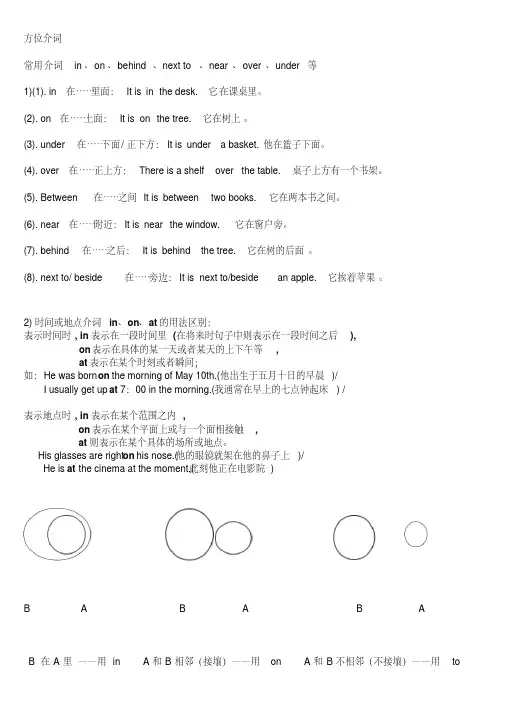
方位介词常用介词in、on、behind、next to、near、over、under等1)(1). in在……里面:It is in the desk.它在课桌里。
(2). on在……上面:It is on the tree.它在树上。
(3). under在……下面/正下方:It is under a basket.他在篮子下面。
(4). over在……正上方:There is a shelf over the table.桌子上方有一个书架。
(5). Between 在……之间It is between two books. 它在两本书之间。
(6). near在……附近:It is near the window. 它在窗户旁。
(7). behind在……之后:It is behind the tree. 它在树的后面。
(8). next to/ beside在……旁边:It is next to/beside an apple. 它挨着苹果。
2)时间或地点介词in、on、at的用法区别:表示时间时, in表示在一段时间里(在将来时句子中则表示在一段时间之后),on表示在具体的某一天或者某天的上下午等,at表示在某个时刻或者瞬间;如:He was born on the morning of May 10th.(他出生于五月十日的早晨)/I usually get up at 7:00 in the morning.(我通常在早上的七点钟起床) /表示地点时, in表示在某个范围之内,on表示在某个平面上或与一个面相接触,at则表示在某个具体的场所或地点。
His glasses are right on his nose.(他的眼镜就架在他的鼻子上)/He is at the cinema at the moment.(此刻他正在电影院)B A B A B AB 在A里——用in A和B相邻(接壤)——用on A和B不相邻(不接壤)——用to。
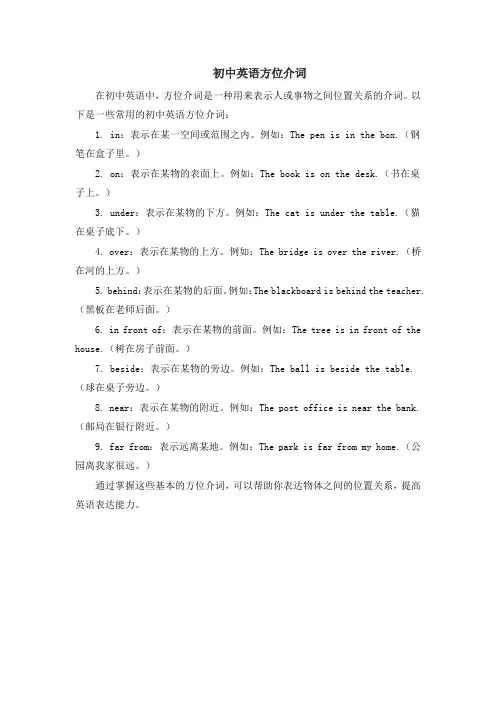
初中英语方位介词在初中英语中,方位介词是一种用来表示人或事物之间位置关系的介词。
以下是一些常用的初中英语方位介词:1. in:表示在某一空间或范围之内。
例如:The pen is in the box.(钢笔在盒子里。
)2. on:表示在某物的表面上。
例如:The book is on the desk.(书在桌子上。
)3. under:表示在某物的下方。
例如:The cat is under the table.(猫在桌子底下。
)4. over:表示在某物的上方。
例如:The bridge is over the river.(桥在河的上方。
)5. behind:表示在某物的后面。
例如:The blackboard is behind the teacher.(黑板在老师后面。
)6. in front of:表示在某物的前面。
例如:The tree is in front of the house.(树在房子前面。
)7. beside:表示在某物的旁边。
例如:The ball is beside the table.(球在桌子旁边。
)8. near:表示在某物的附近。
例如:The post office is near the bank.(邮局在银行附近。
)9. far from:表示远离某地。
例如:The park is far from my home.(公园离我家很远。
)通过掌握这些基本的方位介词,可以帮助你表达物体之间的位置关系,提高英语表达能力。
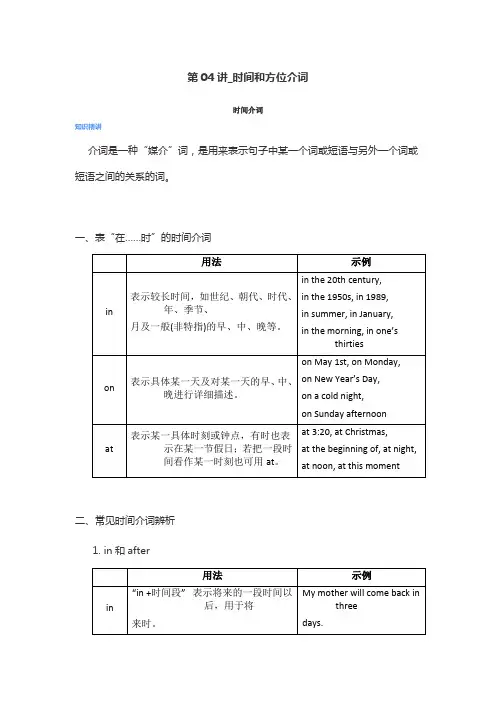
时间介词知识精讲介词是一种“媒介”词,是用来表示句子中某一个词或短语与另外一个词或短语之间的关系的词。
一、表“在……时”的时间介词二、常见时间介词辨析1. in和after2. since和for3. by和till/ until三点剖析一、考点:时间in/ on/ at介词的用法。
二、重难点:时间介词的辨析及用法。
时间介词是中考的考查重点。
时间介词的中考题主要以单项选择以及完形填空等题型来考查。
注意:during表示事件发生在何时(when),意为“在……期间内”的行为或状态。
in 表示时间段,相当于during,但是注意在选择的时候一定要优先选择during。
例:They visited many cities during their stay in China.他们在中国期间,游览了许多城市。
题模精讲题模一表“在…时”的时间介词例1.1、He often goes to school by bike _________ the morning.A、a tB、i nC、o nD、f or例1.2、They started off _________ an autumn afternoon.A、a tB、i nC、o nD、d uring例1.3、用适当的时间介词填空。
I often got up _________ 6 o’clock when I worked in the company _________2008.题模二常见时间介词辨析例2.1、Shanghai Disneyland has started to be built and it will beopen_________ five years.A、i nB、f orC、f romD、b efore例2.2、My uncle has worked at this factory _________ five years.A、s inceB、f orC、a fterD、u ntil例2.3、He lived with his parents _________ he graduated from college.A、d uringB、f orC、b yD、u ntil随堂练习随练1.1、My uncle has worked at this factory _________ five years.A、sinceB、forC、afterD、until随练1.2、Both Mary and Betty will get married this year. Mary is going to begin their honeymoon _________Christmas while Betty _________ New Year’s Day.A、on; onB、at; inC、at; onD、by; on随练1.3、根据句意,用适当的时间介词填空。
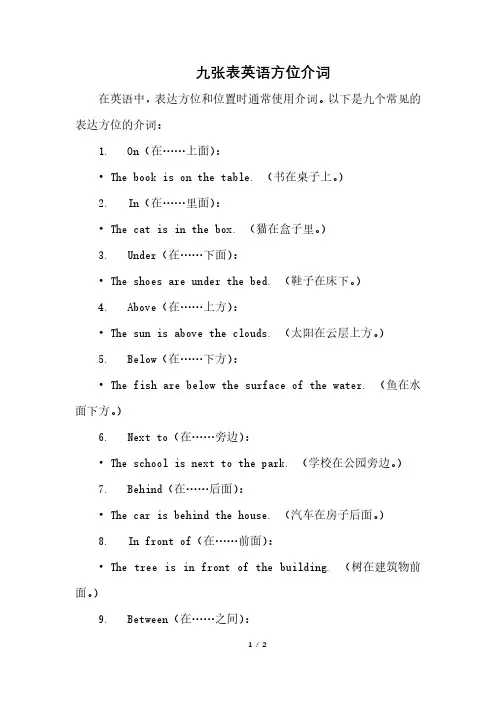
九张表英语方位介词
在英语中,表达方位和位置时通常使用介词。
以下是九个常见的表达方位的介词:
1. On(在……上面):
• The book is on the table. (书在桌子上。
)
2. In(在……里面):
• The cat is in the box. (猫在盒子里。
)
3. Under(在……下面):
• The shoes are under the bed. (鞋子在床下。
)
4. Above(在……上方):
• The sun is above the clouds. (太阳在云层上方。
)
5. Below(在……下方):
• The fish are below the surface of the water. (鱼在水面下方。
)
6. Next to(在……旁边):
• The school is next to the park. (学校在公园旁边。
)
7. Behind(在……后面):
• The car is behind the house. (汽车在房子后面。
)
8. In front of(在……前面):
• The tree is in front of the building. (树在建筑物前面。
)
9. Between(在……之间):
• The shop is between the bank and the pharmacy. (商店在银行和药店之间。
)
这些介词可用于描述物体或位置之间的关系,帮助清晰表达方位。
请注意,具体的使用可能会依赖上下文。
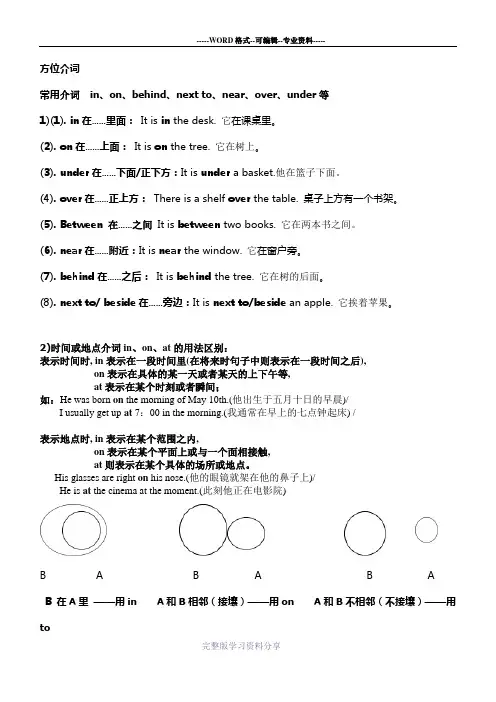
方位介词常用介词in、on、behind、next to、near、over、under等1)(1). in在……里面:It is in the desk.它在课桌里。
(2). on在……上面:It is on the tree.它在树上。
(3). under在……下面/正下方:It is under a basket.他在篮子下面。
(4). over在……正上方:There is a shelf over the table.桌子上方有一个书架。
(5). Between 在……之间It is between two books. 它在两本书之间。
(6). near在……附近:It is near the window. 它在窗户旁。
(7). behind在……之后:It is behind the tree. 它在树的后面。
(8). next to/ beside在……旁边:It is next to/beside an apple. 它挨着苹果。
2)时间或地点介词in、on、at的用法区别:表示时间时, in表示在一段时间里(在将来时句子中则表示在一段时间之后),on表示在具体的某一天或者某天的上下午等,at表示在某个时刻或者瞬间;如:He was born on the morning of May 10th.(他出生于五月十日的早晨)/I usually get up at 7:00 in the morning.(我通常在早上的七点钟起床) /表示地点时, in表示在某个范围之内,on表示在某个平面上或与一个面相接触,at则表示在某个具体的场所或地点。
His glasses are right on his nose.(他的眼镜就架在他的鼻子上)/He is at the cinema at the moment.(此刻他正在电影院)B A B A B AB 在A里——用in A和B相邻(接壤)——用on A和B不相邻(不接壤)——用to3) in front of “在…之前”(范围外)in the front of 表示“在…的前部”(范围内)实战演练1. The United States is ____ the south of Canada and ___ the east of Japan.A. to; inB. on; toC. in; besideD. at; on2 . Japan lies____ the east of China.A. on B/ to C. in D. with3. Jiangsu is___ the east of China, but Japan is ___ the east of China.A. to; inB. in; to .C. on; toD. to; on4. There are some trees_________ the classroomThere is a blackboard ____________ the classroom.A. in front ofB. in the front of5. —Look, there are many apples ______ the tree.—Yes. And a boy is picking apples ______ the tree now.A. in; onB. on; inC. in; inD. on; on6. When did you arrive ______school this morning?A. inB. atC. toD. with。
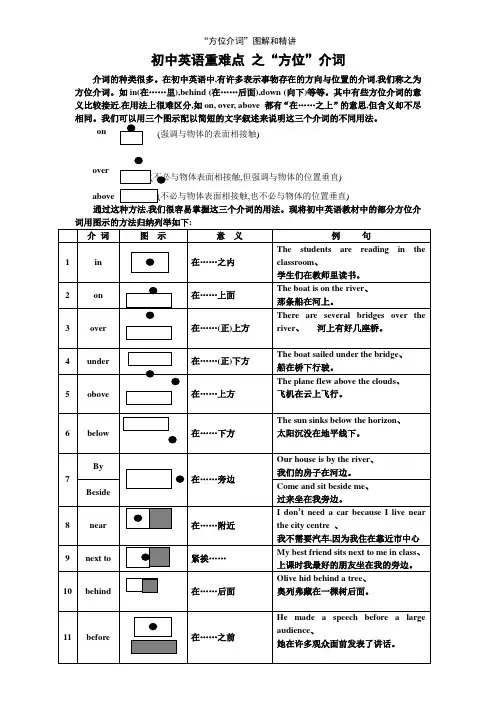
“方位介词”图解和精讲初中英语重难点 之“方位”介词介词的种类很多。
在初中英语中,有许多表示事物存在的方向与位置的介词,我们称之为方位介词。
如in(在……里),behind (在……后面),down (向下)等等。
其中有些方位介词的意义比较接近,在用法上很难区分,如on, over, above 都有“在……之上”的意思,但含义却不尽相同。
我们可以用三个图示配以简短的文字叙述来说明这三个介词的不同用法。
onoverabove(强调与物体的表面相接触) ,但强调与物体的位置垂直)不必与物体表面相接触,也不必与物体的位置垂直)几组方位介词的区别方位介词in, on, to的区别:1.in表示"在……范围内”,还表示“在…之中”Chongqing lies in the southwest of China、2.on表示“与……毗邻,接壤”Canada lies on the north of America、3.to表示方位,不接壤Hunan lies to the east of Zhejiang、表示地点位置的介词:1.at, in, on, toat 用于小地方,at school, at homeIn 用于大地方, in Beijing, in ChinaOn在……上面, on the map, on the tableTo到……To Chongqing2.Above, over, onAbove在……上方(高过另一个物体,不强调垂直)The airplane flies above that tall building、(不在正上方) over在……上方(垂直上方)The bridge spans over the river、On在……上面(物体表面有接触)There's some water on the floor, so you should be careful、3.Below, under在……下面Under在……下(正下方)The cat lies under the chair、(正下方)Below在……下(不一定就是正下方)The cat lies under the chair、(不就是正下方)4.in front of, in the front of 在……的前面in front of 在外部的前面,两个东西就是独立的,相反的就是behind The building is in front of the hospital、The building is behind the hospital、In the front of在内部的前面,属于其中的一部分,相反的就是at the back ofThe girl stands in the front of the classroom、The girl stands at the back of the classroom、5.Beside, near, byBeside在旁边Near在附近By在附近,非常靠近常见方位介词短语(一)、由介词in构成的方位介词短语1、in the front 在前面2、in the front row 在前排3、in the back row 在后排4、in the third row 在第三排5、in front of、、、在、、、前面(范围之外)6、in the front of、、、在、、、前部(范围之内)7、in the middle在中间8、in the street在街上9、in the middle of、、、在中间10、in the tree在树上(指飞鸟等外来物)(二)、由介词at构成的方位介词短语1、at the front of、、、在、、、所在范围的前一部分2、at the back of、、、在、、、所在范围的后一部分3、at the foot of、、、在、、、脚下4、at the top of、、、在、、、顶部5、at the end of、、、在、、、尽头6、at the head of、、、在、、、前头7、at the(school)gate在(校)门口8、at the station 在车站9、at No、2 Chang’an Road在长安路2号10、at my uncle’s 在我叔叔家11、at home在家12、at the doctor’s在医务室/在诊所(三)、由介词on构成的方位介词短语1、on the right/left在右(左)边2、on one’s right/left在某人的右(左)边3、on the desk/table在课桌/桌上4、on the right-hand/left-hand side在右/左手边5、on the blackboard在黑板上6、on/in the wall在墙上/里7、on the paper在纸上8、on the tree在树上(指树上长的,结的东西)三、其它介词构成的方位介词短语1、next to靠近/贴近2、beside the desk在课桌旁3、behind the door在门后4、under the bed在床下5、near the window靠近窗户6、outside the gate在门外。
语法专练(方位介词)1.基础练习一、方位介词in,on, beside ,un der ,above n ext to ,in front of ,beh ind ,betwee n 选词填空1. Beiji ng is ___ the north of China .2. The twins usually sta nd __ t heir pare nts ,and their pare nts are in the middle .3. There is a map of China _________ t he wall of our classroom.4. Before 2000,there was no airli ne _______ the two cities.5. The boy sitting ________ T ina,so she couldn ' t see the film clearly.6.She will leave her homework _________ the teacher ‘ s desk after school today.7. You must ride your bike _________ t he right side of the road.8. Me Smith lives _________ t hat build in g.His house is ___________ t he fifth floor.9. There was an excit ing mome nt in our class whe n a large bird flew __ the room.10. The boy is taller tha n his frien d,so he sits _________him in the classroom.11. The flowers are _______ t he vase on the desk.12.She is the tallest on e.She always sits _______ t he back row.13. He put a painting on the wall ________ the sofa.14. The teacher' s desk is _________ t he front of the classroom.二、选择题( )1 The boat is passing ___ t he bridge.A. throughB. belowC. un derD. across( )2 Two pla nes are flying __ the city.A. throughB. over ,C. on , D, below( )3 We can see a river running to the east ____ t he hill.A. un derB. belowC. overD. on( )4 Do you see the kite ___ t he buildi ng.A. overB. crossC. onD. above( )5 He put up a map _ the back wall because there was a hole ____ it.A. on; onB. at; inC. on; inD. on; at( )6 There is a door __ the wall.A. onB. toC. ofD.in( )7 There are some birds singing __ the trees.A. inB. onC. atD. from( )8 There are so many apples __ t hat tree.A. inB. onC. atD. From( )9 The Un ited States is ___ t he south of Can ada and __ the east of Japa n.A. to; inB. on; toC. in; besideD. at; on( )10 The man stood ____ the win dow, watchi ng the boys play ing outside. A. in B. by C. with D. to( )11 Japa n lies ___ the east of China.A. onB. toC. inD. with( )12 Is the street too n arrow for the bus to go ____ ?A. throughB. acrossC. onD. in( )13 A mother camel was walk ing ___ h er son____ t he desert.A. without; alongB. with; throughC. n ext to; passD. beside; through( )14 The river runs ____ the city.A. acrossB. throughC. overD. from( )15 It took us over an hour to walk ___ this street.A. fromB. throughC. overD. across( )16 Tom sits ____ the classroom while Joh n sits ___ t he room.A. in front of; at back ofB. in the front of; at the back ofC. in front of; at the back ofD. in the front of; at back of( )17 Lucy sits ___ the third row, _____ Jim ‘ s left.A. on; onB. in; atC. at; inD. in; on( )18 Jia ngsu is __ the east of China, but Japa n is ___ t he east of China.A. to; inB. i n; to .C. on; toD. to; on( )19 Don ‘ t read __ the sun.lt ‘ s bad your eyes.A. in; toB. un der; forC. with; toD. in; on( )20 The woman ____ a blue dress is my teacher.A. inB. onC. ofD. at( )21 __ research ___ the uni verse scie ntists have put a lot of in formatio n ________ computers.A. With; over; atB. On; at; toC. In; about; intoD. For; with; through( )22 When a piece of ice is take n ____ a warm room, it gets smaller and smaller un til __ the end it disappears completely.A. in; inB. out of; atC. in to; inD. to; by( )23 A woma n fell ___ the boat ___ the water.A. off; intoB. at; belowC. dow n; un derD. away; inat 用法表示较小的地方,如家、学校等She stayed at home and watched TV yesterday. 她昨天在家看电视。
(完整word版)方位介词初中英语亲爱的读者:本文内容由我和我的同事精心收集整理后编辑发布到文库,发布之前我们对文中内容进行详细的校对,但难免会有错误的地方,如果有错误的地方请您评论区留言,我们予以纠正,如果本文档对您有帮助,请您下载收藏以便随时调用。
下面是本文详细内容。
最后最您生活愉快 ~O(∩_∩)O ~表示位置的介词有:at, in, by, near, between, under表示方向的介词有:to, into, out, out of, across, along, through1 at表示在某地点,强调在某个位置点例:I met her at the school gate this morning. 我今天早上在校门口遇见了她。
at也用于街道号码前例:She lives at 78 Nanjing Road. 她住在南京路78号。
She lives on Nanjing Road. 她住在南京路。
(街道前无号码时用on)She lives in Queen Street. 她住在女王街。
(住在某大街用in)2 in表示“在某区域内,在一个空间的内部,在……里面”例:She was born in Nanjing. 她生于南京。
提示:两个地名连用时,小的用at,大的用in.例:He arrived at London in England last week. 他上周到达英国伦敦。
They will meet at Washington in America. 他们将在美国华盛顿会面。
3 on表示“在……上”,并与之相接触例:He put the dictionary on the desk. 他把词典放在桌子上。
比较英国英语和美国英语的不同介词用法:在路上on the road (美)in the road (英)在街上on the street (美)in the street (英)在周末on the weekend (美)at the weekend (英)在这个队on the team (美)in the team (英)4 under和below表示“在……的正下方”,指垂直上下。
初中英语词汇短语一、方位介词Where is the car?汽车在哪?The car is in front of the garage.汽车在车库前面in front of 在...前面(范围外)in the front of 在...物体内部的前面behind 在...后面in 在...里面on 在...上面above 在...上方below 在...下方over 在...正上方under 在...正下方between 在两者中间among 在...之中(三者以上)next to 紧邻toward 朝;向on top of在...之上near 在...附近about 大约around 在...周围past 经过along 沿着into 到...里面out of 在...之外onto 到...之上off 从...离开up 向上down 向下through (内部)穿过across (表面)穿过二、动词短语break down 出故障(broke 过去式) end up 最终pick up拿;接人;学会;捡起hold up 维持give out 无法继续使用rely on 依赖wear out疲惫不堪put aside 储存keep up with 跟上fall behind 落后catch up on 赶上give up 放弃focus on 集中精力come along 过来fly out 通过飞机离开某地freak out害怕get over 克服run away 逃跑step out 走出去hold back 克制miss out 错过take on 接受;承担go for it 加油open up 敞开split up 分开break off 中断go out 外出get back together 复合let sb.down 让某人失望keep away from 保持距离fall apart 破碎;崩溃turn out 结果是;证明是revolve around 以...为中心stand out 突出;显眼blend into 融入show off 炫耀look down on 鄙视laugh at 嘲笑measure up to 达到标准;符合期望get into 陷入fight over 为...争吵get down on对...表示不满give in屈服;让步put up with 忍受put on 穿上;上演;增加grow apart 渐行渐远bring together 集合;使团结win over 说服;战胜fall for 迷恋ask sb.out 邀请某人出去1bring about 导致start out 开始end up 结束sit around 闲坐wait around 等待stand for 忍耐move on 继续前进;从...中走出stick around 逗留put sb.down 令某人失望go against 违背bring up 教育;培养grow up 长大knock sb.down 使某人倒下lie ahead 在前方boost up鼓励某人rely on 依赖open up 敞开心扉blow away 使惊叹三、日常生活词汇wake up 醒来wash your face 洗脸take a shower 洗个淋浴brush your teeth 刷牙get dressed 穿上衣服brush your hair 刷你的头发do your hair 做你的头发make your bed整理你的床put on makeup 化妆have breakfast吃早餐go to school 去上学drive to work 开车去工作work 工作study 学习wash your hands 洗手have lunch 吃午餐leave school 离开学校get home 到家take a nap 小睡一下have a snack 吃点心do homework 做家庭作业play computer games 玩电脑游戏read a book 阅读一本书play with peers 和同伴玩耍ride a bike 骑单车go shopping 去购物listen to music 听音乐exercise 锻炼mop the floor 拖地vaccum 用真空吸尘器打扫take out the trash 把垃圾带出去water the lawn 给草坪浇水go for a walk 去散步watch TV 看电视do the laundry 洗衣hang the clothes 挂衣服iron the clothes 熨烫衣服do the dishes 洗碗do the dusting做除尘make dinner 做晚饭take a bath 泡澡dry your hair 吹头发go to bed 上床睡觉四、房子词汇房子外部fence 围栏garden花园balcony 阳台chimney 烟囱windows 窗户wall 墙swimming pool 游泳池light 灯door 门attic 阁楼path 小路drainpipe 排水管shutter 百叶窗garage 车库driveway 车道porch 走廊stiars 楼梯basement 地下室roof房顶房子内部attic 阁楼bedroom 卧室living room 客厅laundry room 洗衣房bathroom 浴室study 学习2hallway 走廊dining room饭厅Kitchen 厨房客厅wall 墙floor lamp 落地灯sofa 沙发floor 地板curtains 窗帘window 窗户cushion坐垫table 桌子carpet 地毯armchair 扶手椅picture画chandelier 吊灯air conditioner 空调television 电视television cabinet 电视柜remote control 遥控speaker 扬声器clock 钟fireplace 壁炉bookshelf 书架卧室poster 壁纸lamp台灯pollows 枕头blanket 毛毯alarm clock 闹钟bedside table 床头柜chest of drawers 抽屉柜wardrobe 衣柜dressing table 梳妆台rug 小地毯shelf 柜子bed 床浴室shower淋浴soap 肥皂mirror 镜子sink水槽towel 毛巾light 灯plunger柱塞toilet brush 马桶刷cabinet柜子toilet paper 厕纸toothpaste 牙膏toothbrush 牙刷shampoo 洗发水hair dryer 吹风机comb 梳子hairbrush 发刷sponge 海绵bathtub 浴缸bath mat 浴垫scale 秤toilet厕所洗衣房washing machine 洗衣机laundry 洗衣物laundry basket 洗衣篮ironing board 熨衣板iron 熨斗dustpan 簸箕vacuum cleaner 吸尘器broom 扫把mop 拖把boiler 烧水装置书房drawer 抽屉chair 椅子keyboard 键盘calendar 日历corkboard 公告板monitor 显示器shelf 架子books 书printer 打印机clipboard剪贴板desk lamp 台灯laptop 笔记本电脑folder 文件夹file racks 文件架厨房dishes 盘子sink 水槽pot锅chopping board 砧板range hood抽油烟机kettle 水壶stove 炉子oven 烤箱knives stand刀架counter 柜台blender 搅拌机chair 椅子table 桌子cup 杯子cabinet 柜子refrigerator 冰箱microwave 微波炉dishwasher 洗碗机napkin餐巾纸glass 玻璃杯fork 叉子plate 盘子knife 刀spoon勺子salt shaker 盐瓶glass hanger 挂杯架pan 平底锅3。
“方位介词”图解与精讲(word版可编辑修改)编辑整理:尊敬的读者朋友们:这里是精品文档编辑中心,本文档内容是由我和我的同事精心编辑整理后发布的,发布之前我们对文中内容进行仔细校对,但是难免会有疏漏的地方,但是任然希望(“方位介词”图解与精讲(word 版可编辑修改))的内容能够给您的工作和学习带来便利。
同时也真诚的希望收到您的建议和反馈,这将是我们进步的源泉,前进的动力。
本文可编辑可修改,如果觉得对您有帮助请收藏以便随时查阅,最后祝您生活愉快业绩进步,以下为“方位介词”图解与精讲(word版可编辑修改)的全部内容。
初中英语重难点之“方位”介词介词的种类很多。
在初中英语中,有许多表示事物存在的方向和位置的介词,我们称之为方位介词.如in(在……里),behind (在……后面),down (向下)等等。
其中有些方位介词的意义比较接近,在用法上很难区分,如on, over, above 都有“在……之上”的意思,但含义却不尽相同.我们可以用三个图示配以简短的文字叙述来说明这三个介词的不同用法.on(强调与物体的表面相接触)通过这种方法,我们很容易掌握这三个介词的用法.现将初中英语教材中的部分方位介词用图示的方法归纳列举如下:几组方位介词的区别方位介词in, on, to的区别:1.in表示"在……范围内”,还表示“在…之中" Chongqing lies in the southwest of China。
2.on表示“与……毗邻,接壤"Canada lies on the north of America.3.to表示方位,不接壤Hunan lies to the east of Zhejiang.表示地点位置的介词:1.at, in, on, toat 用于小地方,at school, at homeIn 用于大地方, in Beijing, in ChinaOn在……上面, on the map, on the tableTo到…… To Chongqing2.Above, over, onAbove在……上方(高过另一个物体,不强调垂直)The airplane flies above that tall building。
介词用法总结地点时间方向介词用法总结——地点、时间、方向介词是英语中非常重要的一部分,它能够表达地点、时间、方向等概念。
在下面的文章中,将对地点、时间和方向三个方面的介词用法进行总结,并给出相应的例句。
地点1. 在(at)在用于表示地点时,处于表面、建筑物、城市等地。
例如:- 我在图书馆学习。
(I am studying at the library.)- 她在家。
(She is at home.)2. 在……里面(in)在表示地点时,强调人或物在物体的内部。
例如:- 他在书房里工作。
(He is working in the study.)- 我们在教室里见面。
(We will meet in the classroom.)3. 在……之间(between)在表示地点时,用于两个物体或地点之间。
例如:- 那座桥横跨在两座山之间。
(The bridge is between two mountains.)- 我的家和学校之间有一条小路。
(There is a path between my house and school.)4. 在……附近(near)表示地点时,表示某物或某人靠近某个地点。
例如:- 邮局就在这附近。
(The post office is near here.)- 我家附近有一家超市。
(There is a supermarket near my house.)时间1. 在……之前(before)在表示时间时,表示某一事件发生前的时间点。
例如:- 学生们在考试之前要复习。
(Students need to review before the exam.)- 我们在见面之前先吃饭。
(Let's have dinner before we meet.)2. 在……期间(during)在表示时间时,表示某一事件发生的整个期间。
例如:- 我们在假期期间去了海滩。